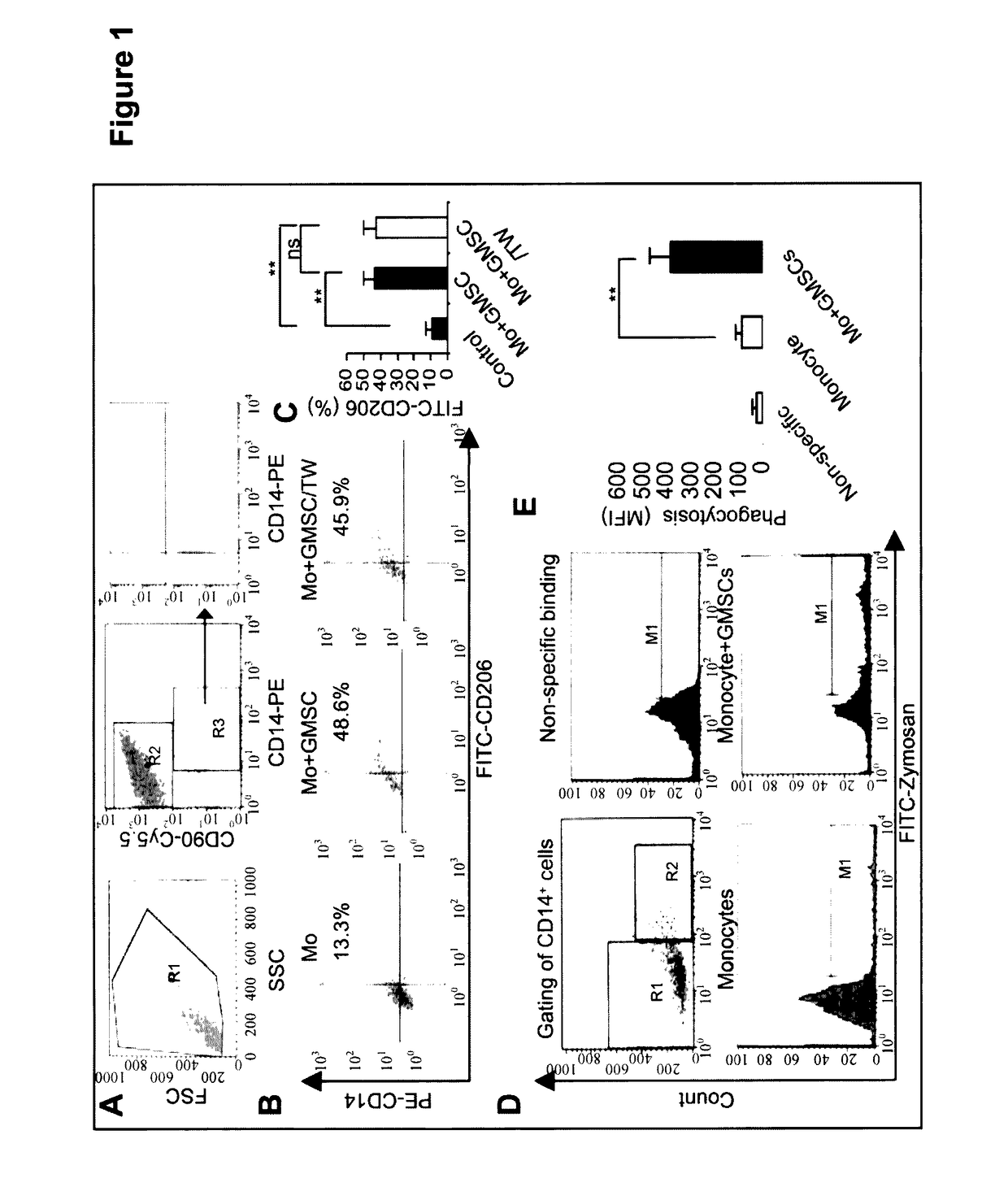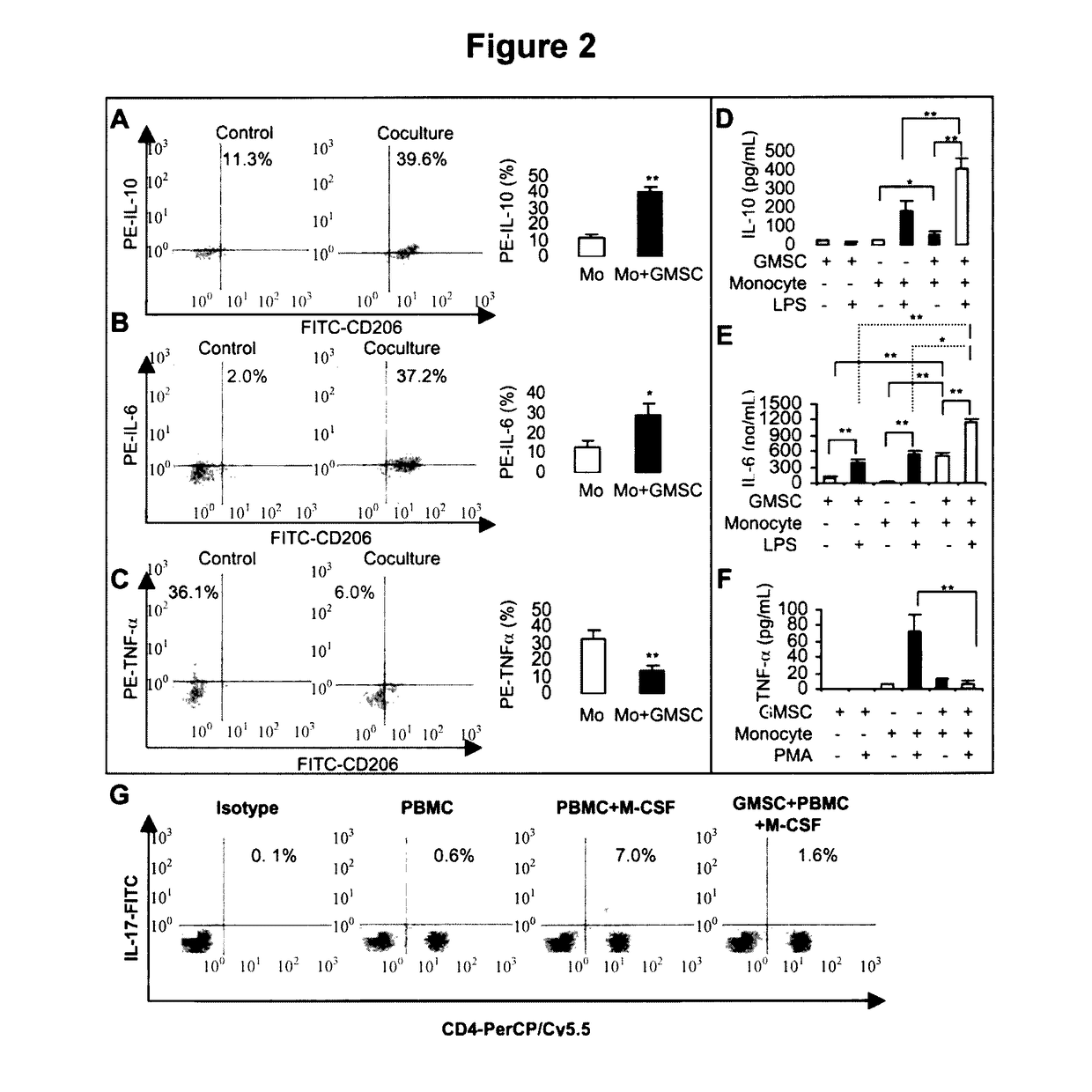Methods of promoting wound healing and attenuating contact hypersensitivity with gingiva-derived mesenchymal stem cells
a stem cell and mesenchymal stem cell technology, applied in the field of stem cell therapy, can solve the problems of difficult identification of allergens to improve contact avoidance, abnormal wound healing in diabetic patients, scarring and fibrotic diseases, etc., and achieve the effect of rapid ex vivo expansion and ease of isolation
- Summary
- Abstract
- Description
- Claims
- Application Information
AI Technical Summary
Benefits of technology
Problems solved by technology
Method used
Image
Examples
example i.b
GMSCs Induce Anti-Inflammatory Immune Profile in Macrophages in Co-Culture
[0059]Next, we determined the cytokine expression profile by macrophages co-cultured with GMSCs. Flow cytometric analysis showed that, in comparison with macrophages cultured alone, co-culture with GMSCs significantly increased the percentage of macrophages expressing IL-10 (FIG. 2A) and IL-6 (FIG. 2B), while decreased TNF-α-positive macrophages (FIG. 2C) following stimulation using different protocols as previously described [20]. The differential cytokine profile of secretory IL-10, IL-6, and TNF-α in the supernatants of macrophages, GMSCs, and their co-cultures, was further confirmed by ELISA, respectively. Minimal release of cytokines was observed in macrophages or GMSCs alone in the absence of stimuli (FIG. 2D, 2F). Addition of stimulating agents triggered a burst of IL-10 and TNF-α secretion by macrophages, but had minimal effect on GMSCs cultured alone (FIG. 2D, 2F). The increased secretion of IL-10 tri...
example 1
Interplay Between GMSCs and Macrophages Regulated the Local Inflammatory Response During Skin Wound Healing
[0064]We next investigated the in vivo effects of GMSCs on inflammatory cell response and production of local inflammatory cytokines in skin wounds. Analysis of skin wounds on day 3, 5, and 7 following GMSC injection indicated that infiltration of inflammatory cells was significantly decreased in GMSC-treated wounds as compared to controls (FIG. 6C). GMSC treatment decreased neutrophil infiltration as represented by a time-dependent decrease in MPO activity in wounded skin at several time points post-wounding (FIG. 6Da). In addition, ELISA analysis showed that GMSC treatment significantly decreased the local levels of both proinflammatory cytokines, TNF-α and IL-6, and increased the anti-inflammatory cytokine IL-10 (FIG. 6Db-d). Without being limited by theory, it is believed that GMSC treatment promotes skin wound healing, at least in part, by suppressing inflammatory cell inf...
example i
Materials and Methods Used in Example I
[0066]Animals.
[0067]C57BL / 6J mice (male, 8-10 week-old) were obtained from Jackson Laboratories (Bar Harbor, Me., http: / / www.jax.org) and group-housed at the Animal Facility of University of Southern California (USC). All animal care and experiments were performed under the institutional protocols approved by the Institutional Animal Care and Use Committee (IACUC) at USC.
[0068]Cytokines and Reagents.
[0069]Recombinant human IL-4, CCL-2 (MCP-1), IL-6 and M-CSF were purchased from PeproTech (Rocky Hill, N.J., http: / / www.peprotech.com). Lipopolysaccharide (LPS) from Escherichia coli 055:B5, phorbol 12-myristate 13-acetate (PMA), Brefeldin A were obtained from Sigma-Aldrich (St. Louis, Mo., http: / / www.sigmaaldrich.com). Antibodies include anti-CD14 allophycocyanin (APC), anti-CD11a fluorescein isothiocyanate (FITC), anti-CD90 peridinin chlorophyll protein (PerCp)-Cy5.5, anti-IL-6-PE, anti-IL-10-PE, anti-TNFα-PE and anti-IL-17-FITC (eBiosciences, San...
PUM
 Login to View More
Login to View More Abstract
Description
Claims
Application Information
 Login to View More
Login to View More - R&D
- Intellectual Property
- Life Sciences
- Materials
- Tech Scout
- Unparalleled Data Quality
- Higher Quality Content
- 60% Fewer Hallucinations
Browse by: Latest US Patents, China's latest patents, Technical Efficacy Thesaurus, Application Domain, Technology Topic, Popular Technical Reports.
© 2025 PatSnap. All rights reserved.Legal|Privacy policy|Modern Slavery Act Transparency Statement|Sitemap|About US| Contact US: help@patsnap.com



